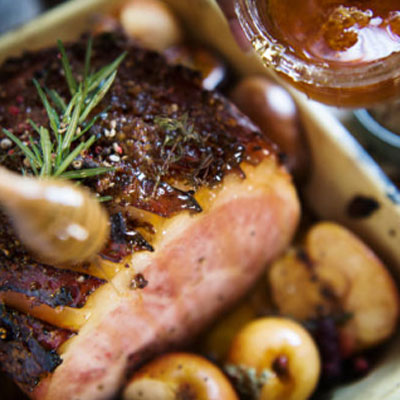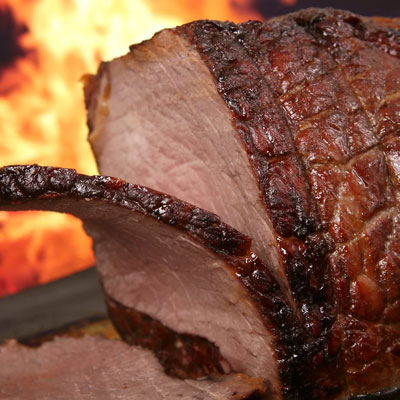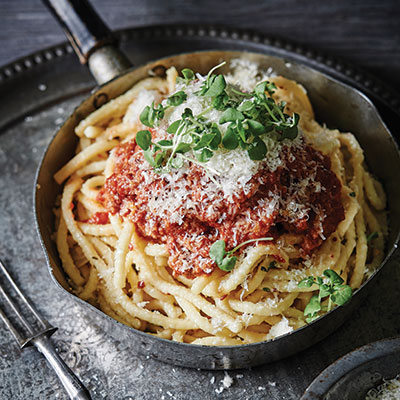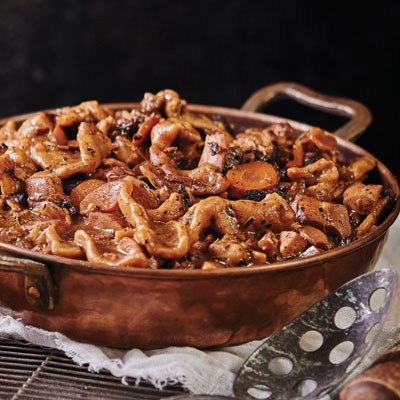7 classic recipes everyone should know how to make
It’s time to revive some old-school American classics. If Grandma didn’t teach you right, keep reading for help from St. Louis pros. From Caesar salad to baked ham and mashed potatoes, these seven recipes will never go out of style.
Baked Ham
If your holiday isn’t complete without a beautiful glazed ham, call your butcher shop this year and place an order for uncooked country ham instead of a bagged, precooked option. They’re a bit more work, so we turned to Juniper chef-owner John Perkins to guide us through the days of soaking, baking and glazing to make a proper country ham worth the wait. – Dee Ryan
Soak Don’t freak out, but when you remove the ham from the packaging, it might have some mold on it. Like an aged cheese, a little mold is normal. Place the ham in a large pot (or new cooler) and cover it with cold water – it has to soak at least 24 to 48 hours. Change the water every eight hours or so to properly leach the salt from the ham. After 12 to 24 hours, remove it and scrape off any mold with a knife. Rinse the ham, place it back into the pot and cover with fresh water to soak another 24 hours, changing the water every eight hours.
Bake After soaking, preheat the oven to 300 degrees. Rinse the ham thoroughly and place it on a rack in a roasting pan filled with 1 to 2 inches of water and 1 roughly chopped onion. Tent the ham tightly with foil and bake 20 minutes per pound until the internal temperature reaches 163 degrees. Let the ham rest at room temperature 1 hour, then remove as much of the skin as you can. Start at the hock (the small end) and trim away the tough outer skin, leaving as much fat as possible on the ham. (There is no need to score before you glaze since the skin has been removed.)
Glaze Now it’s time to glaze. Preheat the oven to 325 degrees, baste the ham with your preferred glaze (recipes on p. 41), and bake 30 minutes, basting every 10 minutes. Remove from oven and continue to baste as it cools.
Serve Ham is tastiest served slightly warm or at room temperature. To present the ham, first cut a slice from the bottom to make a flat base. Start about 2 inches from the hock and make a cut straight through to the bone. From there, make thin parallel cuts perpendicular to the bone. To release the slices, cut parallel along the bone from the small end. Wham, bam, thank you, ham.
If you prefer the ease of a precooked ham, look for brands like Frick’s Quality Meats, available at most area grocery stores. Be sure to score a precooked ham before you glaze and bake it.
Save that bone to add depth to a pot of greens or beans. Once completely cool, wrap the bone tightly in two layers of plastic wrap and one layer of foil, then toss it in the freezer. Bone-in, uncooked country ham ($4 per pound) is available at Kenrick’s Meat Market and Catering, 4324 Weber Road, St. Louis, 314.632.2440, kenricks.com.
Ginger Ale Ham Glaze
Adapted from a recipe by Juniper’s John Perkins
1 cup
1 cup Blenheim’s or Bruce Cost ginger ale
¼ cup brown sugar
2 Tbsp. sorghum or molasses
2 Tbsp. whole-grain Dijon mustard
• In a saucepan over low heat, combine all ingredients. Stirring occasionally, simmer until slightly thickened, about 15 minutes.
Cola Ham Glaze
Adapted from a recipe by Dierberg’s School of Cooking’s Marianne Moore
1 cup
1 cup brown sugar
1 cup cola
½ cup maple syrup
2 Tbsp. Dijon mustard
2 Tbsp. whole-grain mustard
½ tsp. ground cloves
½ tsp. ground ginger
• In a saucepan over low heat, combine all ingredients. Stirring occasionally, simmer until slightly thickened, about 15 minutes.

Classic Old-Fashioned
A classic Old-Fashioned is the granddaddy of whiskey cocktails. The simple, time-honored trio of whiskey, bitters and sugar is best complemented by the natural sweetness of cherry and fresh orange. Dustin Parres, corporate bar manager at Gamlin Whiskey House, contended that technique makes the Old-Fashioned so special – something often ignored by bartenders who slap the drink together using bottled juices and bland, mass-produced cherries. “If they aren’t breaking out a muddler, you know that they’re doing it wrong,” Parres said. Check out his take on the classic. – Matt Berkley
Old-Fashioned
Courtesy of Gamlin Whiskey House’s Dustin Parres
1 serving
3 Luxardo maraschino cherries, divided
2 small orange slices, divided
1 Demerara sugar cube
A few dashes Angostura bitters
2 oz. Henry McKenna bottled-in-bond bourbon
½ oz. Dolin Blanc vermouth
• In a pint glass or shaker, muddle together 2 cherries, 1 orange slice, the sugar cube and bitters. Pour in the bourbon and the vermouth. Add a few ice cubes, cover and shake. Pour through a fine-mesh sieve into an Old-Fashioned glass, snifter or rocks glass filled with large ice cubes. Garnish with the remaining cherry and orange slice.

Caesar Salad
Few salads are more iconic than Caesar. We turned to chef Kier Puckett at Mike Shannon’s Steaks & Seafood for his take on this steakhouse classic. Step one: Put down that bottled dressing. This umami-packed DIY version uses raw egg yolks, white anchovy fillets, roasted garlic and cold olive oil – Puckett’s secret to a thick, rich dressing. Step two: Give the emperor of salads a proper throne. Add the dressing to a nonreactive wooden or glass serving bowl, then toss with crisp romaine. Hail, Caesar! – Lauren Schumacker
For a charred take on a Caesar salad, cut hearts of romaine in half lengthwise and drizzle with olive oil. Briefly grill over high heat until the romaine just wilts and chars slightly. Serve whole, drizzled with Caesar salad dressing.
Caesar Salad
Courtesy of Mike Shannon’s Steaks & Seafood’s Kier Puckett
4 servings
2 to 4 slices grilled baguette, plus more for serving
4 white anchovy fillets,* coarsely chopped
3 roasted garlic cloves
2 egg yolks
¼ cup grated Parmigiano-Reggiano
1 Tbsp. lemon juice
1 tsp. Dijon mustard
Dash Worcestershire sauce
½ cup cold olive oil
Kosher salt and freshly ground black pepper, to taste
6 heads romaine lettuce, chopped
• In the bowl of a food processor, pulse the baguette slices to create about ⅓ cup breadcrumbs. Add the anchovy fillets, garlic, egg yolks, Parmigiano-Reggiano, lemon juice, mustard and Worcestershire and puree until well blended. With the machine running, add the oil in a slow stream to emulsify. Season to taste with salt and pepper.
• Pour the dressing into a serving bowl. Add the romaine and toss to coat. Serve with grilled baguette slices.
*Available at Straub’s, 8262 Forsyth Blvd., Clayton, 314.725.2121, straubs.com

Spaghetti and Meatballs
Randolfi’s chef-owner Mike Randolph makes light, airy meatballs loaded with flavor. Here, four tips from the pro for magical meatballs at home. – Meera Nagarajan
Ditch the breadcrumbs. Airy meatballs start with high-quality bread. Cube a day-old artisanal loaf and soak it in buttermilk; this will help bind the mixture and keep it moist. Sturdy bread lends itself to a softer, fluffier meatball, and buttermilk is a great way to add acid to the meat, which means better flavor in the finished product.
Bigger is better. If you want a light, soft texture, make a couple large meatballs instead of dozens of little ones. They’re less likely to dry out during cooking, and it’s less work for you.
You don’t boil a steak; don’t boil meatballs. The best way to cook meatballs is to season well, sear, add a simple tomato puree and braise two to three hours in a 225-degree oven.
Don’t neglect the noodles. Spaghetti and meatballs is mostly spaghetti. For a new take on the classic, toss al dente pasta in a pan with a generous glug of olive oil, your favorite herbs, a splash of pasta water and a sprinkle of Parmesan. It’s a great accompaniment to the meat and a simple alternative to the expected tomato sauce.
Make ho-hum store-bought tomato sauce sing with help from Stellina chef-owner Jamey Tochtrop: Pour 3 cups dry red wine in a saucepan and add 6 cloves roughly chopped garlic, 2 roughly chopped large shallots, 1 small roughly chopped carrot and 6 to 8 thyme sprigs. Slowly reduce by half over low heat until thick and syrupy. Strain out the solids, then fold the desired amount into store-bought tomato sauce for added depth and complexity.
Meatballs
Courtesy of Randolfi’s Mike Randolph
4 to 6 servings
6 oz. artisanal day-old white bread, cut into ¼-inch cubes (about 3½ cups)
1½ cups buttermilk
1¼ lbs. ground lamb
1¼ lbs. ground pork
1 egg
2½ tsp. chopped fresh garlic
2 tsp. lemon zest
2 tsp. kosher salt
1¼ tsp. chopped fresh rosemary
1 tsp. freshly ground black pepper
1 tsp. red pepper flakes
¾ tsp. chopped fresh thyme
¾ tsp. fennel pollen*
1 Tbsp. olive oil
1 14.5-oz. can whole peeled San Marzano tomatoes, pureed
Spaghetti with Herbs and Cheese (recipe follows)
Finely grated Parmigiano-Reggiano
• Preheat the oven to 225 degrees.
• In a large bowl, soak the bread in the buttermilk about 20 minutes. Add ¼ pound lamb and ¼ pound pork to the bread mixture and mix until well incorporated. Add the remaining lamb, the remaining pork, the egg, garlic, lemon zest, salt, rosemary, black pepper, red pepper flakes, thyme and fennel pollen and mix well. Use your hands to form the meat mixture into baseball-sized meatballs, 6- to 8-ounces each.
• In a large skillet, heat the oil over medium-high heat. Working in batches, brown the meatballs, turning every few minutes to sear all sides, about 10 minutes. Place the meatballs in a 9-by-13-inch glass baking dish.
• Pour the tomato puree into the skillet over medium-high heat. Scrape any browned bits from the bottom of pan with a wooden spoon. Pour the sauce over the meatballs.
• Bake 2 hours. Serve over spaghetti. Garnish with Parmigiano-Reggiano.
*Available at Larder & Cupboard, 7310 Manchester Road, Maplewood, 314.300.8995, larderandcupboard.com
Spaghetti with Herbs and Cheese
Courtesy of Randolfi’s Mike Randolph
4 servings
1 lb. dried spaghetti
½ cup olive oil
4 garlic cloves, minced
2 Tbsp. minced shallot
1 cup grated Parmesan
3 Tbsp. chopped fresh parsley
½ tsp. red pepper flakes
4 tsp. lemon juice
Salt and freshly ground black pepper, to taste
• Bring a large pot of salted water to boil over high heat. Add the spaghetti and cook until just shy of al dente, 6 to 7 minutes. Reserve 2 cups pasta water, then drain the spaghetti and set aside.
• Return the pot to the stove over medium heat and add the oil. Add the garlic and shallot and cook 2 to 3 minutes, until translucent. Add the spaghetti, Parmesan, parsley, red pepper flakes and 1 cup pasta cooking water. Toss until the spaghetti is cooked to al dente and the sauce coats the pasta, about 5 minutes. Add more pasta cooking water as needed if the sauce is too thick. Stir in lemon juice and salt and pepper to taste.

Mashed Potatoes and Gravy
Nothing says love like a big bowl of mashed potatoes and gravy. Every family has its favorite rendition of this classic dish, and even the pros disagree about some things. Kevin Nashan, chef-owner of Peacemaker Lobster & Crab Co. and Sidney Street Cafe, prefers a rough mash of partially peeled, small red potatoes or fingerlings. Gerard Craft, chef-owner of the Niche Food Group, goes for a smooth puree of russet potatoes. Nashan seasons his water; Craft doesn’t. But lumpy or whipped, fingerlings or russets, milk or cream, there are some things all good mashers can agree upon. – D.R.
6 Steps to the Perfect Mash
1. Cut about 3 pounds potatoes (such as russet, fingerling or small red potatoes) into equal 1½ - to 2-inch cubes.
2. Place those spuds in a very large pot of cold water and give them room to dance with 1 inch of water above them. Set the pot over medium-high heat.
3. Put a fork in it. Three pounds of potatoes cooked over medium-high take about 30 to 35 minutes. When a fork goes in easily or breaks the potato, drain immediately. If the potatoes fight back, continue to cook, checking every 5 minutes. Pay attention: Overcooked potatoes make a soupy mash.
4. Burn calories while you mash. The paddle attachment on a stand mixer works, but it is easy to go from perfection to glue when using appliances. Keep it old-school with a wire masher and leave some lumps, if you’re into that. If you like a silky-smooth texture, use a potato ricer.
5. Use about 1 stick melted butter and ½ cup milk, half-and-half or cream for every 3 pounds potatoes. Always warm the butter and liquid before adding them.
6. Don’t be bland. Add salt and white pepper to taste – start with 1 teaspoon salt and a couple grinds of pepper and go from there. Other additions may include roasted garlic, creme fraiche or sour cream and, of course, cheese. Try mascarpone, goat cheese, cheddar or Parmesan. You can also add a little chicken or beef stock diluted in warm milk.
Ham Gravy
Traditionally, gravy is built from the pan drippings of roasted meat. So what do you do when baked ham, the drippings from which will be a sugary glaze, is on the menu? More importantly, how do you avoid lumpy gravy – a punishable crime in most homes? The trick is to start with a roux.
Nashan suggested making the roux with a fat-rich slice of precooked ham about the size of a matchbook. Dice it up, then sear it in a large saucepan over medium-low heat until browned, 3 to 5 minutes. Add 1 tablespoon butter, then stir in 4 chopped fresh sage leaves and 1 tablespoon minced shallot. Cook 1 minute, stirring occasionally, then remove the ham and set aside. Stir in 3 more tablespoons butter until melted, then whisk in 6 tablespoons all-purpose flour and cook until golden, 3 to 4 minutes, stirring constantly. The roux should be the consistency of custard. If it’s thin, add a bit more flour.
To finish the gravy, whisk in ¼ cup room-temperature dry white wine. The roux will likely seize a bit, so don’t worry if it rolls into a ball. Stir in 1¼ cups room temperature pork stock, whisking constantly. As you whisk, the roux will turn into gravy in 3 to 5 minutes. For the smoothest gravy, pour it through a fine-mesh sieve, pressing solids with the back of a spoon, or for more texture, stir the reserved ham into gravy.

Chicken and Dumplings
Chris Vomund, Herbie’s Vintage ’72 executive chef, has taken traditional chicken and dumplings in some surprising flavor directions. Start with the classic recipe, then dream up your own flavor combinations or try one of Vomund’s ideas below. – Rebecca Koening
Shake up the traditional chicken and dumplings and spike the broth with different flavors.
• miso + mushrooms
• tomatoes, zucchini, yellow squash + red wine
• ginger + lemongrass
• juniper + marjoram
Chicken and Dumplings
Adapted from a recipe by Herbie’s Vintage ’72’s Chris Vomund
4 servings
1/3 cup olive oil
4 Tbsp. white wine vinegar, divided
2 lbs. boneless, skin-on chicken thighs*
2 Tbsp. butter
2 carrots, sliced
2 large celery ribs, sliced
2 garlic cloves, minced
1 small onion, diced
2 tsp. dried rosemary, divided
2 tsp. dried sage, divided
2 tsp. dried thyme, divided
2 cups dry white wine
6 cups chicken stock
2¹∕³ cups flour, divided, plus more for dusting
1½ tsp. kosher salt, divided
¾ cup water
½ tsp. freshly ground black pepper
• In a large mixing bowl, whisk together the olive oil and 2 tablespoons vinegar. Add the chicken thighs and toss to coat. Cover and refrigerate overnight.
• In a large Dutch oven over medium-high heat, melt the butter. Meanwhile, pat the chicken dry with paper towels. Cook the chicken skin-side down until browned and the fat renders, 10 to 15 minutes. Flip the chicken and cook another 5 minutes, then transfer to a cutting board. Pour all but 1 tablespoon pan drippings into a measuring cup. It should total about ¼ cup.
• Add the carrots, celery, garlic and onion to the Dutch oven over medium heat and cover, stirring occasionally, until the vegetables are tender, about 10 minutes. Add 1 teaspoon rosemary, 1 teaspoon sage and 1 teaspoon thyme and stir about 30 seconds. Increase heat to high, add the wine and the remaining 2 tablespoons vinegar and boil 5 minutes. Add the chicken stock and return to a boil, then decrease the heat to medium-low and simmer 30 minutes to reduce.
• Meanwhile, prepare the dumpling dough: On a clean work surface, combine 2 cups flour and 1 teaspoon salt with your hands. Gather the flour into a mound and make a well in the center. Slowly add the water, mixing with your hand until a dough starts to form. Knead the dough a few times to form a ball, but do not overwork.
• Lightly sprinkle the work surface and a rolling pin with flour. Roll the dough to 1∕8- to ¼-inch thickness and sprinkle with the remaining 1 teaspoon rosemary, 1 teaspoon sage and 1 teaspoon thyme. Fold the dough in half, then roll out again to 1∕8- to ¼-inch thickness. Use a sharp knife to slice the dough into 1½-inch pieces. Set aside.
• In a small saucepan over low heat, prepare a roux by whisking together the reserved ¼ cup pan drippings and the remaining ¹∕³ cup flour until well blended. Cook about 5 minutes, whisking frequently.
• Pour the roux into the Dutch oven and bring to a boil over high heat. Meanwhile, cut the chicken into 1-inch chunks. Stir in the chicken, pepper and the remaining ½ teaspoon salt, then add the dumpling dough to the stew, making sure the dough pieces don’t touch. Gently shake the Dutch oven to coat the dumplings in liquid. Return to a boil, then reduce heat to medium-low, cover and simmer 30 minutes, gently shaking the Dutch oven occasionally.
*Ask your butcher to debone skin-on chicken thighs, but save the bones to make stock.
Tags : Recipes










